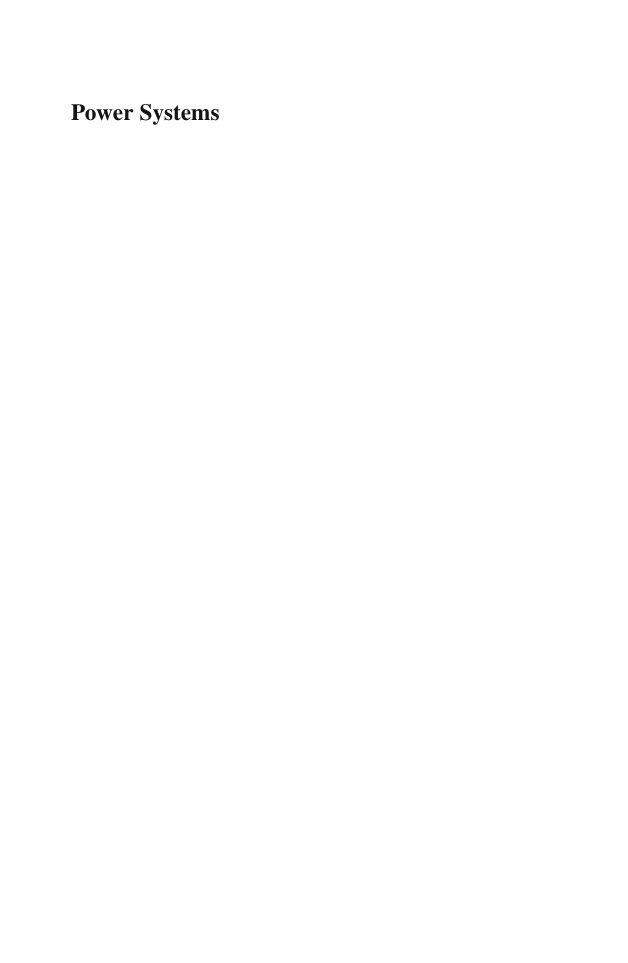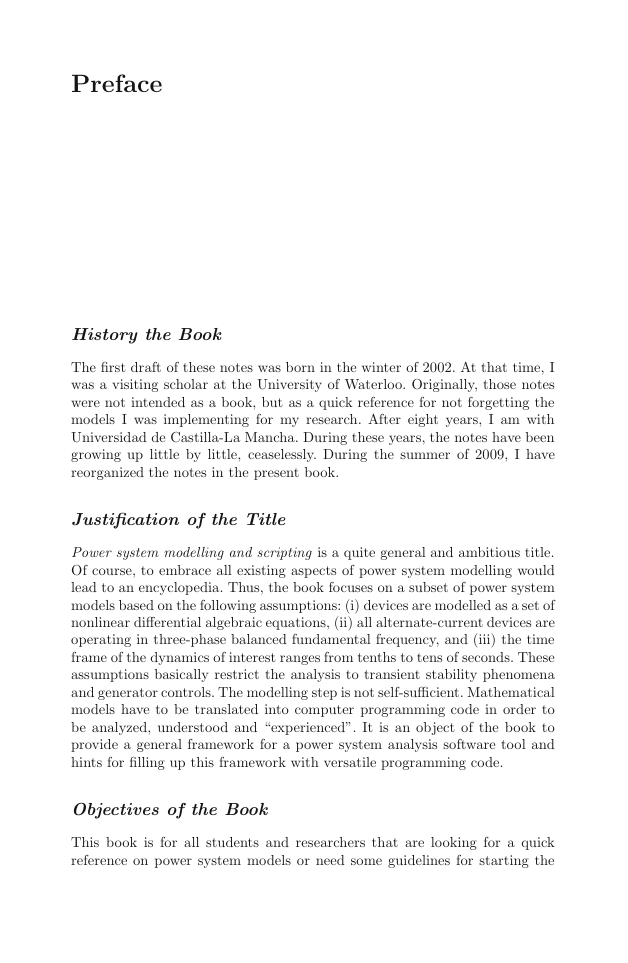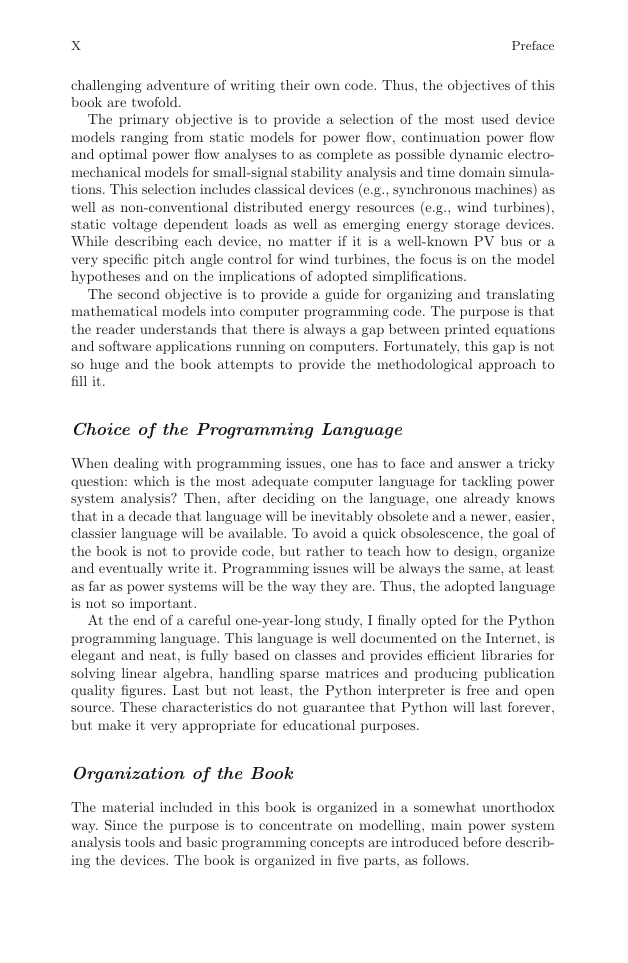1
2
Introduction
3
Power System Modelling
Background
Motivations
Modelling Physical Systems
Hybrid Dynamical Model
4
Power System Architecture
Structure of Software Projects
Classes and Procedures
Modularity
Architecture of a Power System Software Tool
5
Power System Scripting
Open and Closed Programming
Scripting
Scripting Languages for Computational Science
Computer Languages Suitable for Power System Analysis
Python Scripting Language
7
Power System Analysis
8
Power Flow Analysis
Background
Taxonomy of Power Flow Problems
Classical Power Flow Equations
Power Flow Solvers
Jacobi and Gauss-Seidel’s Method
Newton’s Method
Power Flow Jacobian Matrix
Robust Newton’s Method
Iwamoto’s Method
Inexact and Dishonest Newton’s Methods
Fast Decoupled Power Flow
DC Power Flow
Single and Distributed Slack Bus Models
A General Framework for Power Flow Solvers
Stability of the Continuous Newton’s Method
Summary
9
Continuation Power Flow Analysis
Background
System Model
Direct Methods
Saddle-Node Bifurcation
Limit-Induced Bifurcation
Nonlinear Programming
Homotopy Methods
Continuation Power Flow
Predictor Step
Corrector Step
Continuous Newton’s Method and Homotopy
N-1 Contingency Analysis
Summary
10
Optimal Power Flow Analysis
Background
Optimal Power Flow Model
Nonlinear Programming Solvers
Generalized Reduced Gradient Method
Interior Point Method
Summary of IPM Parameters
11
Eigenvalue Analysis
Background
Small Signal Stability Analysis
Bifurcation Points
Participation Factors
Analysis in the Z-Domain
Computing the Eigenvalues
Power Method
Inverse Iteration
Rayleigh’s Iteration
Power Flow Modal Analysis
Singular Value Decomposition
Summary
12
Time Domain Analysis
Background
Power System Model
Current-Injection Model
Power-Injection Model
Numerical Integration Methods
Explicit Methods
Implicit Methods
Numerical Integration Routine
Step Length
Disturbances
Stop Criterion
Electro-magnetic Transients
Quasi-static Analysis
Summary
13
Device Models
14
Device Generalities
General Device Model
Initialization of Device Internal Variables
Devices as Classes
Base Device Class
Methods of the Base Class
15
Power Flow Devices
Topological Elements
Bus
Areas, Zones, Regions and Systems
Static Generators
PV Generator
Constant Voltage Phasor Generator
PQ Generator
Static Loads
PQ Load
Constant Power Factor Load
Shunt Admittance
Switched Shunt Admittances
16
Transmission Devices
Transmission Line
Line Sections
Tie Line
Distributed Transmission Line Models
Effect of Frequency Variation
Coupling Device and Zero-Impedance Line
Transformer
Two-Winding Transformer
Under Load Tap Changer
Phase Shifting Transformer
Three-Winding Transformer
Vectorial Implementation
Incidence Matrix
Jacobian and Hessian Matrices
Network Connectivity
17
OPF Devices
Network Constraints
Bus Voltage Limits
Transmission Line limits
Generator Constraints
Capability Curve
Supply Offer
Reactive Power Payment Function
Generator Power Reserve
Generator Power Ramp
Load Constraints
Demand Bid
Demand Daily Profile
Demand Power Ramp
18
Faults and Protections
Fault
Breaker
Relay
Phasor Measurement Unit
Bus Frequency Estimation
19
Loads
Voltage Dependent Load
ZIP Load
Frequency Dependent Load
Voltage Dependent Load with Dynamic Tap Changer
Exponential Recovery Load
Thermostatically Controlled Load
Jimma’s Load
Mixed Load
20
Alternate-Current Machines
Synchronous Machine
Synchronous Machine Parameters
Initialization
Common Equations
Stator Electrical Equations
Magnetic Equations
Simplified Magnetic Equations
Synchronous Machine Model Taxonomy
Saturation
Center of Inertia
Dynamic Shaft
Sub-synchronous Resonance
Induction Machine
Initialization
Torque Model
Electromechanical Model
Detailed Single-Cage Model
Detailed Double-Cage Model
21
Synchronous Machine Regulators
Turbine Governor
Turbine Governor Type I
Turbine Governor Type II
Automatic Voltage Regulator
Automatic Voltage Regulator Type I
Automatic Voltage Regulator Type II
Automatic Voltage Regulator Type III
Power System Stabilizer
Simplified Power System Stabilizer Model
Power System Stabilizer Type I
Power System Stabilizer Type II
Power System Stabilizer Type III
Over-Excitation Limiter
Under-Excitation Limiter
22
Direct-Current Devices
Direct-Current Nodes
Common Interface Equations for Direct-Current Devices
Ideal Generators
Basic RLC Models
Direct-Current Machines
Other Direct-Current Devices
Solid Oxide Fuel Cell
Solar Photovoltaic Cell
Battery Energy System
23
AC/DC Devices
High-Voltage Direct-Current Transmission System
Per Unit System for DC Quantities
Rectifier Model
Inverter Model
HVDC Control
Voltage Source Converter
Simplified Dynamic VSC Model
Power Flow VSC Model
24
FACTS Devices
Static Var Compensator
SVC Type I
SVC Type II
SVC Initialization
Thyristor Controlled Series Compensator
TCSC Initialization
Static Synchronous Compensator
Detailed Model
Simplified Dynamic Model
Power Flow Model
STATCOM Initialization
Static Synchronous Series Compensator
Detailed Model
Simplified Dynamic Model
Power Flow Model
SSSC Initialization
Unified Power Flow Controller
Detailed Model
Simplified Dynamic Model
Power Flow Model
UPFC Initialization
25
Wind Power Devices
Wind Speed Models
Weibull’s Distribution
Composite Wind Speed Model
Mexican Hat Wavelet Model
Wind Turbines
Single Machine and Aggregate Models
Wind Turbine Initialization
Turbine Model
Dynamic Shaft
Non-Controlled Speed Wind Turbine
Doubly-Fed Asynchronous Generator
Direct-Drive Synchronous Generator
26
Spare Material and Concluding Remarks
27
Data Formats
Data Format Taxonomy
Data Organization and Structures
Kind of Supported Data
Number of Files
Default Values, Prototypes and Data Manipulation
Canonical Model
Common Information Model
Consistent Data Schemes
28
Visualization Matters
Graphical Interface vs. Command Line Approach
Result Visualization
Standard Two-Dimensional Plots
Temperature Maps
Three-Dimensional Plots
Geographic Information System
29
Challenges of Scripting for Power System Education
Concepts and Definitions
Proprietary Software
Open Source Software
Free Software
Free Open Source Software
Education-Oriented FOSS
Pedagogical Issues
Failure of FOSS for Power System Analysis
30
















 2023年江西萍乡中考道德与法治真题及答案.doc
2023年江西萍乡中考道德与法治真题及答案.doc 2012年重庆南川中考生物真题及答案.doc
2012年重庆南川中考生物真题及答案.doc 2013年江西师范大学地理学综合及文艺理论基础考研真题.doc
2013年江西师范大学地理学综合及文艺理论基础考研真题.doc 2020年四川甘孜小升初语文真题及答案I卷.doc
2020年四川甘孜小升初语文真题及答案I卷.doc 2020年注册岩土工程师专业基础考试真题及答案.doc
2020年注册岩土工程师专业基础考试真题及答案.doc 2023-2024学年福建省厦门市九年级上学期数学月考试题及答案.doc
2023-2024学年福建省厦门市九年级上学期数学月考试题及答案.doc 2021-2022学年辽宁省沈阳市大东区九年级上学期语文期末试题及答案.doc
2021-2022学年辽宁省沈阳市大东区九年级上学期语文期末试题及答案.doc 2022-2023学年北京东城区初三第一学期物理期末试卷及答案.doc
2022-2023学年北京东城区初三第一学期物理期末试卷及答案.doc 2018上半年江西教师资格初中地理学科知识与教学能力真题及答案.doc
2018上半年江西教师资格初中地理学科知识与教学能力真题及答案.doc 2012年河北国家公务员申论考试真题及答案-省级.doc
2012年河北国家公务员申论考试真题及答案-省级.doc 2020-2021学年江苏省扬州市江都区邵樊片九年级上学期数学第一次质量检测试题及答案.doc
2020-2021学年江苏省扬州市江都区邵樊片九年级上学期数学第一次质量检测试题及答案.doc 2022下半年黑龙江教师资格证中学综合素质真题及答案.doc
2022下半年黑龙江教师资格证中学综合素质真题及答案.doc